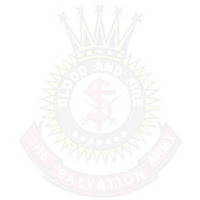
THE VANISHING ARMY
By David Woodbury
In the 25th chapter of Genesis, we have the story
of Esau selling his birthright; his rights as the firstborn son, to his brother
Jacob for a pot of stew. The essence of the story was that in his desperate
hunger, Esau surrenders his inheritance. As I look back over my life as a
Salvationist, I am wondering whether or not, in our desperate hunger to appear
relevant, we have traded our birthright.
I am well aware that the church must always find relevant
connections with the society in which it exists. The problem is that today, the
culture and philosophies of the world in which we exist are changing at a rapid
rate. The instant exposure to ideas,
thought patterns, trends etc. in this internet age is producing generations
that find themselves on a constant, ever-accelerating continuum of relentless
change. The end result of chasing this elusive phantom of relevance may well
result in The Salvation Army, as an organisation, becoming confused as to our
calling, and as a result, ineffective.
As I look back over my many years as a Salvationist I can
see a gradual demilitarisation of The Salvation Army, where many of the
characteristics that made us unique and distinctive have been gradually removed
or diluted. Probably some needed to go. I can clearly remember standing in a
Sunday morning open air in Australia in 100 plus heat, decked up in a
high-collar, serge uniform and thinking that The Salvation Army must be crazy.
However, perhaps it is time to seriously review some of the changes that may
well have had well-intentioned motivation, but in hindsight have led to this demilitarisation
of the Army.
The Founder and his soldiers had a very clear and focussed vision
of their calling. They called it; Salvation Warfare, and everything that
they devised, constructed and actioned, was directed at a war against sin and
its consequences. Since the end of WW2, many changes have taken place in Army
culture and mindset, most of them not all that impactful in themselves; in fact,
some have almost gone unnoticed.
Somewhere in the last half of the 20th century, a
revision was made of the document, The
Articles of War, signed by all
those who wish to become Salvationists. The document was somewhat demilitarised
and the word “war” removed from its title (although it does appear in the last
paragraph), and the document became; A
Soldier’s Covenant.
Among the other changes to the document the last phrase was
removed where the recruit swore; by God's
help, to be a true soldier of The Salvation Army till I die. It was replaced by the abbreviated: by God's help, to be a true soldier of The
Salvation Army. I suspect the thinking was that it was unfashionable or
unrealistic for people to make such a commitment. However, covenants are about
ideals; what I hope to achieve, rather than the actualities of my somewhat
feeble performance. While ever ideals are held high, performance will be
greater. It could be argued that a lifelong commitment to be a true soldier
of The Salvation Army till I die gave early Salvationists a resource
and an energy that enabled them to do extraordinary things for God.
The use of distinctive Salvation Army music with its
emphasis on salvation warfare and holiness has been neglected. In their place,
there have arisen fashionable styles of worship music which tend to be more
one-directional and self-centred, with their focus simply on a personal experience
of worship.
In many centres, the holiness table is no longer present and
the mercy seat is employed for all manner of activities, such as write on a piece of paper or pick up
a stone etc., rather than the call to true repentance and salvation.
Many Salvation Army centres and publications now carry a
cross. However, it wasn’t so long ago the display of a cross in Salvation Army
centres required that it had an “S”, signifying the central purpose of the
Army’s mission, entwined on it.
Salvation Army centres are no longer referred to as “corps”,
but rather “church”. While I would be the first to admit that “corps” is probably
irrelevant terminology in today’s world, the use of “church” is quite contrary
to the way the Founder and his early Salvationists viewed their organisation.
Perhaps the use of the word “mission” may be a better terminology
Over recent years the crest, with all its inherent and
significant symbolism, has been replaced by the Red Shield logo. While I
understand the necessity for uniform branding, the reality is that there is
little, if any, significant symbolism inherent in the logo.
The Salvation Army uniform has now changed with a multitude
of “T” shirts or similar attire now available. Very few, if any, carry the symbolic
pair of “S” which epitomises the twin aims of the Army: Saved to serve. Such attire in some places is available to anyone
who chooses to purchase it, be they officer, soldier, employee or other.
The term Salvo is used instead of The Salvation Army, with the
significance of an army being removed.
While it may be that the general community may use this terminology, perhaps
more as a vernacular term, by adopting it within the organisation we dilute our
descriptive name.
The abandonment of rank and titles; I notice in my territory
recently the territorial commander and his wife being referred to in an
official communique by only their Christian names. I am well aware that in many
parts of the world today we live in an egalitarian society. However, by the abandonment
of rank and titles, we further demilitarise our organisation.
The upshot of many of these changes is that some of these
characteristics that made us unique and distinctive have been removed or
diluted, leaving us a pale imitation of the military like fighting force of The
Founders day. General Andre Cox in his farewell message in the May issue of Others, quoted the words of The Founder,
William Booth, which may well be relevant: “When The Salvation Army ceases to
be a militant body of red-hot men and women whose supreme business is the
saving of souls, I hope it will vanish utterly.” We would hope that The
Founder’s words are not prophetic in our day.
From about 900 BC until around 1905, the Chinese used a form
of execution/torture known as Lingchi , or Death by a thousand cuts, where
minimal, non-lethal cuts were inflicted on the victim. Although the wounds in
themselves were not life-threatening, their cumulative result was. I will leave
the reader to draw their own conclusion.









Comments
Post a Comment